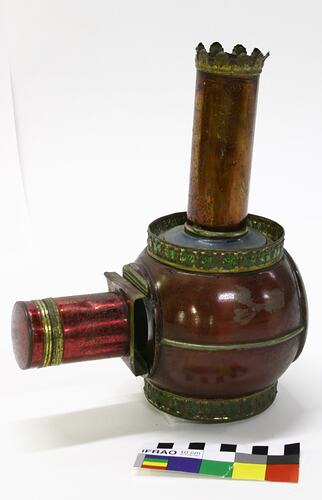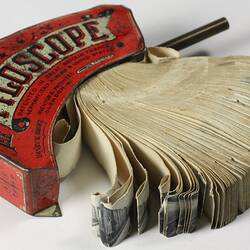Summary
A beautiful magic lantern produced for home use. The lampascope was designed to fit on top of a domestic oil lamp to utilise its light and thus did not require its own illuminant.
Lampascopes such as this were a product of France and appear to date from 1861. The majority were globular in shape, such as this particular model. Many were coloured using an alcohol based varnish, often in an array of exuberant colours.
The Lapierre family and Louis Aubert were the two most prominent producers of this type of lantern however there were many other producers, both large firms and individual craftsmen. This particular lantern is a match for the Lapierre produced 'Boule' lampascopes.
While the invention of the magic lantern is generally seen to be in the 17th century, its greatest popularity as an optical projector spans the late 18th Century to the early decades of the 20th Century. It was used both as a means of entertainment and education.
This lantern projector is part of the Francis Collection of pre-cinematic apparatus and ephemera, acquired by the Australian and Victorian Governments in 1975. David Francis was the curator of the National Film and Sound Archive of the British Film Institute as well as being a co-founder of the Museum of the Moving Image in London, which was operational between 1988 and 1999.
Physical Description
A red lacquered lamposcope of globular shape with a crown top cylindrical chimney. Lacquered detailing is in gold and green. The floor has a hole, designed to fit over a domestic oil lamp which provided the illumination. The projection lens is protected by a removable cap.
More Information
-
Collection Names
-
Collecting Areas
-
Acquisition Information
Loan & Subsequent Donation from Australian Film Institute (AFI), Mr David Francis, by Nov 1990
-
Collector
Mr David Francis, London, Middlesex, England, Great Britain, 1990
-
Classification
Photography, Image viewing equipment, Lantern projector lighting
-
Category
-
Discipline
-
Type of item
-
Overall Dimensions
325 mm (Height)
-
Overall Dimensions
120 mm (Width), 195 mm (Depth), 550 mm (Height)
Dimensions when three parts put together.
-
Maximum dimensions
193 mm (Length), 125 mm (Width), 242 mm (Height)
Measurement From Conservation.
-
Keywords
Lantern Projectors, Magic Lanterns, Projectors, Innovation & Design

